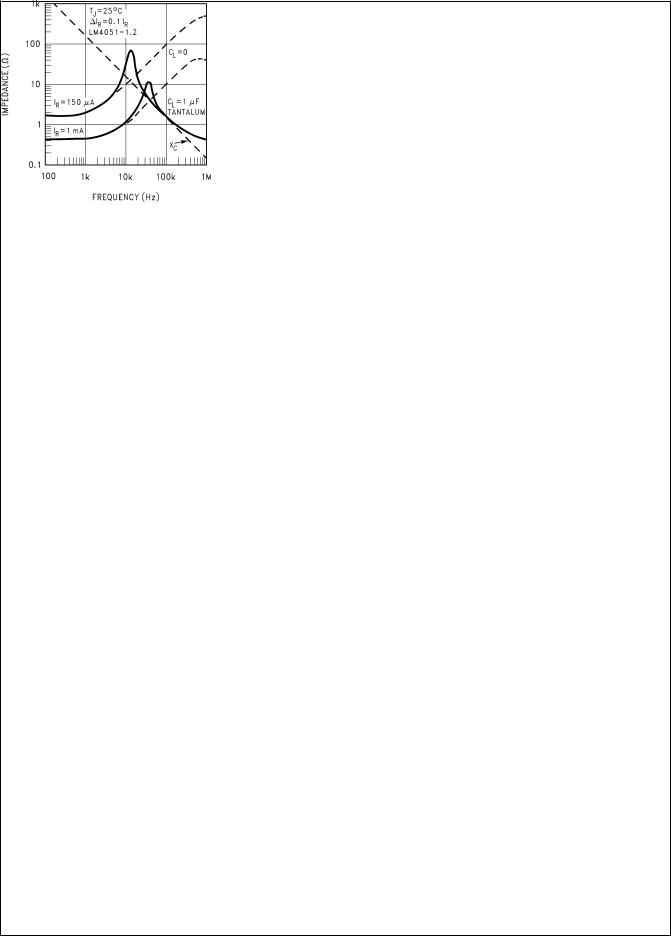NSC LM4051AIM3X-ADJ, LM4051AIM3-ADJ, LM4051AIM3-1.2, LM4051CIM3X-ADJ, LM4051CIM3X-1.2 Datasheet
...
February 2000
LM4051
Precision Micropower Shunt Voltage Reference
General Description
Ideal for space critical applications, the LM4051 precision voltage reference is available in the sub-miniature (3 mm x 1.3 mm) SSOT-23 surface-mount package. The LM4051's advanced design eliminates the need for an external stabilizing capacitor while ensuring stability with any capacitive load, thus making the LM4051 easy to use. Further reducing design effort is the availability of a fixed (1.225V) and adjustable reverse breakdown voltage. The minimum operating current is 60 µA for the LM4051-1.2 and the LM4051-ADJ. Both versions have a maximum operating current of 12 mA.
The LM4051 comes in three grades (A, B, and C). The best grade devices (A) have an initial accuracy of 0.1%, while the B-grade have 0.2% and the C-grade 0.5%, all with a tempco of 50 ppm/ÊC guaranteed from −40ÊC to 125ÊC.
The LM4051 utilizes fuse and zener-zap trim of reference voltage during wafer sort to ensure that the prime parts have an accuracy of better than ±0.1% (A grade) at 25ÊC.
Features
nSmall packages: SSOT-23
nNo output capacitor required
nTolerates capacitive loads
nReverse breakdown voltage options of 1.225V and adjustable
Key Specifications (LM4051-1.2)
n Output voltage tolerance |
|
(A grade, 25ÊC) |
±0.1%(max) |
n Low output noise |
|
(10 Hz to 10kHz) |
20µVrms |
n Wide operating current range |
60µA to 12mA |
n Industrial temperature range |
−40ÊC to +85ÊC |
(tempco guaranteed from |
|
−40ÊC to +125ÊC) |
|
n Low temperature coefficient |
50 ppm/ÊC (max) |
Applications
nPortable, Battery-Powered Equipment
nData Acquisition Systems
nInstrumentation
nProcess Control
nEnergy Management
nAutomotive and Industrial
nPrecision Audio Components
nBase Stations
nBattery Chargers
nMedical Equipment
nCommunication
Connection Diagrams
SSOT-23
DS101222-40
DS101222-1
*This pin must be left floating or connected to pin 2.
Top View
See NS Package Number MF03A
Reference Voltage Shunt Micropower Precision LM4051
© 2000 National Semiconductor Corporation |
DS101222 |
www.national.com |

LM4051
Ordering Information
Reverse Breakdown |
LM4051 Supplied as |
LM4051 Supplied as |
Part Marking |
Voltage Tolerance at 25ÊC and |
1000 Units, Tape and |
3000 Units, Tape and |
|
Average Reverse Breakdown |
Reel |
Reel |
|
Voltage Temperature Coefficient |
|
|
|
|
|
|
|
±0.1%, 50 ppm/ÊC max (A grade) |
LM4051AIM3-1.2 |
LM4051AIM3X-1.2 |
RIA |
|
|
|
|
|
LM4051AIM3-ADJ |
LM4051AIM3X-ADJ |
RHA |
|
|
|
|
±0.2%, 50 ppm/ÊC max (B grade) |
LM4051BIM3-1.2 |
LM4051BIM3X-1.2 |
RIB |
|
|
|
|
|
LM4051BIM3-ADJ |
LM4051BIM3X-ADJ |
RHB |
|
|
|
|
±0.5%, 50 ppm/ÊC max (C grade) |
LM4051CIM3-1.2 |
LM4051CIM3X-1.2 |
RIC |
|
|
|
|
|
LM4051CIM3-ADJ |
LM4051CIM3X-ADJ |
RHC |
|
|
|
|
SOT-23 Package Marking Information
Only three fields of marking are possible on the SSOT-23's small surface. This table gives the meaning of the three fields.
Field Definition
First Field:
R = Reference
Second Field:
I = 1.225V Voltage Option
H = Adjustable
Third Field:
A±C = Initial Reverse Breakdown
Voltage or Reference Voltage Tolerance
A = ±0.1%, B = ±0.2%, C = ±0.5%
www.national.com |
2 |

Absolute Maximum Ratings (Note 1)
If Military/Aerospace specified devices are required, please contact the National Semiconductor Sales Office/ Distributors for availability and specifications.
Reverse Current |
20 mA |
Forward Current |
10 mA |
Maximum Output Voltage |
|
(LM4051-ADJ) |
15V |
Power Dissipation (TA = 25ÊC) (Note 2) |
|
M3 Package |
280 mW |
Storage Temperature |
−65ÊC to +150ÊC |
Lead Temperature |
|
M3 Packages |
|
Vapor phase (60 seconds) |
+215ÊC |
Infrared (15 seconds) |
+220ÊC |
ESD Susceptibility |
|
Human Body Model (Note 3) |
2 kV |
Machine Model (Note 3) |
200V |
See AN-450 ªSurface Mounting Methods and Their Effect on Product Reliabilityº for other methods of soldering surface mount devices.
Operating Ratings(Notes 1, 2)
Temperature Range |
(Tmin ≤ TA ≤ Tmax) |
Industrial Temperature Range |
−40ÊC ≤ TA ≤ +85ÊC |
Reverse Current |
|
LM4051-1.2 |
60 µA to 12 mA |
LM4051-ADJ |
60 µA to 12 mA |
Output Voltage Range |
|
LM4051-ADJ |
1.24V to 10V |
LM4051-1.2
Electrical Characteristics
Boldface limits apply for TA = TJ = TMINto TMAX; all other limits TA = TJ = 25ÊC. The grades A, B and C designate initial Reverse Breakdown Voltage tolerances of ±0.1%, ±0.2% and ±0.5% respectively.
Symbol |
Parameter |
Conditions |
Typical |
LM4051AIM3 |
LM4051BIM3 |
LM4051CIM3 |
Units |
|
(Note 4) |
(Limits) |
(Limits) |
Limts |
(Limit) |
||||
|
|
|
|
(Note 5) |
(Note 5) |
(Note 5) |
||
|
|
|
|
|
|
|||
|
|
|
|
|
|
|
|
|
VR |
|
Reverse Breakdown |
IR = 100 µA |
1.225 |
|
|
|
V |
|
|
Voltage |
|
|
|
|
|
|
|
|
|
|
|
|
|
|
|
|
|
Reverse Breakdown |
IR = 100 µA |
|
±1.2 |
±2.4 |
±6 |
mV (max) |
|
|
Voltage |
|
|
|
|
|
|
|
|
Tolerance (Note 6) |
|
|
± 5.2 |
± 6.4 |
± 10.1 |
mV (max) |
|
|
|
|
|
|
|
|
|
IRMIN |
|
Minimum Operating |
|
39 |
|
|
|
µA |
|
|
Current |
|
|
60 |
60 |
60 |
µA (max) |
|
|
|
|
|
65 |
65 |
65 |
µA (max) |
|
|
|
|
|
|
|
|
|
VR/ |
T |
Average Reverse |
IR= 10 mA |
±20 |
|
|
|
ppm/ÊC |
|
|
Breakdown |
IR = 1 mA |
±15 |
|
|
|
ppm/ÊC |
|
|
Voltage Temperature |
IR = 100 µA |
±15 |
± 50 |
± 50 |
± 50 |
ppm/ÊC |
|
|
Coefficient (Note 6) |
||||||
|
|
T = −40ÊC to 125ÊC |
|
|
|
|
(max) |
|
|
|
|
|
|
|
|
||
|
|
|
|
|
|
|
|
|
VR/ |
IR |
Reverse Breakdown |
IRMIN ≤ IR ≤ 1 mA |
0.3 |
|
|
|
mV |
|
|
Voltage |
|
|
1.1 |
1.1 |
1.1 |
mV (max) |
|
|
Change with Operating |
|
|
1.5 |
1.5 |
1.5 |
mV (max) |
|
|
Current Change |
|
|
||||
|
|
|
|
|
|
|
|
|
|
|
1 mA ≤ IR ≤ 12 mA |
1.8 |
|
|
|
mV |
|
|
|
|
|
|
|
|||
|
|
|
|
|
6.0 |
6.0 |
6.0 |
mV (max) |
|
|
|
|
|
8.0 |
8.0 |
8.0 |
mV (max) |
|
|
|
|
|
|
|
|
|
ZR |
|
Reverse Dynamic |
IR = 1 mA, f = 120 Hz |
0.5 |
|
|
|
Ω |
|
|
Impedance |
|
|
|
|
|
|
|
|
|
|
|
|
|
|
|
eN |
|
Wideband Noise |
IR = 100 µA |
20 |
|
|
|
µV rms |
|
|
|
10 Hz ≤ f ≤ 10 kHz |
|
|
|
|
|
|
|
|
|
|
|
|
|
|
VR |
|
Reverse Breakdown |
t = 1000 hrs |
|
|
|
|
|
|
|
Voltage |
T = 25ÊC ±0.1ÊC |
120 |
|
|
|
ppm |
|
|
Long Term Stability |
IR = 100 µA |
|
|
|
||
|
|
|
|
|
|
|
||
|
|
(Note 9) |
|
|
|
|
|
|
|
|
|
|
|
|
|
|
|
VHYST |
Output Hysteresis |
T = −40ÊC to 125ÊC |
0.36 |
|
|
|
mV/V |
|
|
|
(Note 10) |
|
|
|
|
|
|
|
|
|
|
|
|
|
|
|
LM4051
3 |
www.national.com |

LM4051
LM4051-ADJ (Adjustable)
Electrical Characteristics
Boldface limits apply for TA = TJ = TMINto TMAX; all other limits TJ = 25ÊC unless otherwise specified (SSOT-23, see (Note 7)
,IRMIN £ IR £ 12 mA, VREF £ VOUT £ 10V. The grades A, B and C designate initial Reference Voltage Tolerances of ±0.1%,
±0.2% and ±0.5%, respectively for VOUT = 5V.
Symbol |
Parameter |
Conditions |
Typical |
LM4051AIM3 |
LM4051BIM3 |
LM4051CIM3 |
Units |
|
(Note 4) |
(Note 5) |
(Note 5) |
(Note 5) |
(Limit) |
||||
|
|
|
||||||
|
|
|
|
|
|
|
|
|
VREF |
Reference Voltage |
IR = 100 µA, VOUT = 5V |
1.212 |
|
|
|
V |
|
|
Reference Voltage |
IR = 100 µA, VOUT = 5V |
|
±1.2 |
±2.4 |
±6 |
mV (max) |
|
|
Tolerance (Note 6), |
|
|
± 5.2 |
± 6.4 |
± 10.1 |
mV (max) |
|
|
(Note 8) |
|
|
|
|
|
|
|
|
|
|
|
|
|
|
|
|
IRMIN |
Minimum Operating |
|
36 |
|
|
|
µA |
|
|
Current |
|
|
60 |
60 |
65 |
µA (max) |
|
|
|
|
|
65 |
65 |
70 |
µA (max) |
|
|
|
|
|
|
|
|
|
|
DVREF/DIR |
Reference |
IRMIN £ IR £ 1mA |
0.3 |
|
|
|
mV |
|
|
VoltageChange with |
VOUT ³ 1.6V |
|
1.1 |
1.1 |
1.1 |
mV (max) |
|
|
Operating Current |
(Note 7) |
|
1.5 |
1.5 |
1.5 |
mV(max) |
|
|
Change |
|
|
|
|
|
|
|
|
1 mA £ IR £ 12 mA |
0.6 |
|
|
|
mV |
||
|
|
VOUT ³ 1.6V(Note 7) |
|
6 |
6 |
6 |
mV (max) |
|
|
|
|
|
8 |
8 |
8 |
mV (max) |
|
|
|
|
|
|
|
|
|
|
DVREF/DVO |
Reference Voltage |
IR = 0.1 mA |
−1.69 |
|
|
|
mV/V |
|
|
Changewith Output |
|
|
−2.8 |
−2.8 |
−2.8 |
mV/V (max) |
|
|
Voltage Change |
|
|
−3.5 |
−3.5 |
−3.5 |
mV/V (max) |
|
|
|
|
|
|
|
|
|
|
IFB |
Feedback Current |
|
70 |
|
|
|
nA |
|
|
|
|
|
130 |
130 |
130 |
nA (max) |
|
|
|
|
|
150 |
150 |
150 |
nA (max) |
|
|
|
|
|
|
|
|
|
|
DVREF/DT |
Average |
VOUT = 2.5V |
|
|
|
|
|
|
|
ReferenceVoltage |
IR = 10mA |
20 |
|
|
|
ppm/ÊC |
|
|
Temperature |
IR = 1mA |
15 |
|
|
|
ppm/ÊC |
|
|
Coefficient (Note 8) |
|
|
|
||||
|
IR = 100µA |
15 |
± 50 |
± 50 |
± 50 |
ppm/ÊC |
||
|
|
|||||||
|
|
|
|
|
|
|
(max) |
|
|
|
DT = −40ÊC to +125ÊC |
|
|
|
|
|
|
ZOUT |
Dynamic Output |
IR = 1 mA, |
|
|
|
|
|
|
|
Impedance |
f = 120 Hz, |
|
|
|
|
|
|
|
|
IAC = 0.1 IR |
|
|
|
|
|
|
|
|
VOUT = VREF |
0.3 |
|
|
|
W |
|
|
|
VOUT = 10V |
2 |
|
|
|
W |
|
eN |
Wideband Noise |
IR = 100 µA |
20 |
|
|
|
µVrms |
|
|
|
VOUT = VREF |
|
|
|
|
|
|
|
|
10 Hz £ f £ 10 kHz |
|
|
|
|
|
|
|
Reference Voltage |
t = 1000 hrs, |
120 |
|
|
|
ppm |
|
DVREF |
Long Term Stability |
IR = 100 µA |
|
|
|
|
|
|
|
(Note 9) |
T = 25ÊC ±0.1ÊC |
|
|
|
|
|
|
|
|
|
|
|
|
|
|
|
VHYST |
Output Hysteresis |
DT = −40ÊC to +125ÊC |
0.3 |
|
|
|
mV/V |
|
|
(Note 10) |
|
|
|
|
|
|
|
|
|
|
|
|
|
|
|
www.national.com |
4 |

Electrical Characteristics (continued)
Note 1: Absolute Maximum Ratings indicate limits beyond which damage to the device may occur. Operating Ratings indicate conditions for which the device is functional, but do not guarantee specific performance limits. For guaranteed specifications and test conditions, see the Electrical Characteristics. The guaranteed specifications apply only for the test conditions listed. Some performance characteristics may degrade when the device is not operated under the listed test conditions.
Note 2: The maximum power dissipation must be derated at elevated temperatures and is dictated by TJmax (maximum junction temperature), θJA (junction to ambient thermal resistance), and TA (ambient temperature). The maximum allowable power dissipation at any temperature is PDmax = (TJmax − T A)/θJA or the number given in the Absolute Maximum Ratings, whichever is lower. For the LM4051, TJmax = 125ÊC, and the typical thermal resistance (θJA), when board mounted, is 280ÊC/W for the SSOT-23 package.
Note 3: The human body model is a 100 pF capacitor discharged through a 1.5 kΩ resistor into each pin. The machine model is a 200 pF capacitor discharged directly into each pin.
Note 4: Typicals are at TJ = 25ÊC and represent most likely parametric norm.
Note 5: Limits are 100% production tested at 25ÊC. Limits over temperature are guaranteed through correlation using Statistical Quality Control (SQC) methods. The limits are used to calculate National's AOQL.
Note 6: The boldface (over-temperature) limit for Reverse Breakdown Voltage Tolerance is defined as the room temperature Reverse Breakdown Voltage Tolerance
±[( V R/ T)(max T)(VR)]. Where, VR/ T is the VR temperature coefficient, max T is the maximum difference in temperature from the reference point of 25 ÊC to T MAX or TMIN, and VR is the reverse breakdown voltage. The total over-temperature tolerance for the different grades in the industrial temperature range where max T=65ÊC is shown below:
A-grade: ±0.425% = ±0.1% ±50 ppm/ÊC x 65ÊC
B-grade: ±0.522% = ±0.2% ±50 ppm/ÊC x 65ÊC
C-grade: ±0.825% = ±0.5% ±50 ppm/ÊC x 65ÊC
Therefore, as an example, the A-grade LM4051-1.2 has an over-temperature Reverse Breakdown Voltage tolerance of ±1.2V x 0.425% = ±5.2 mV.
Note 7: When VOUT ≤ 1.6V, the LM4051-ADJ in the SSOT-23 package must operate at reduced IR. This is caused by the series resistance of the die attach between the die (-) output and the package (-) output pin. See the Output Saturation curve in the Typical Performance Characteristics section.
Note 8: Reference voltage and temperature coefficient will change with output voltage. See Typical Performance Characteristics curves.
Note 9: Long term stability is VR @ 25ÊC measured during 1000 hrs.
Note 10: Thermal hysteresis is defined as the changes in 25ÊC output voltage before and after cycling the device from −40ÊC or +125ÊC.
Typical Performance Characteristics
Temperature Drift for Different |
Output Impedance vs Frequency |
Average Temperature Coefficient |
|
DS101222-19
DS101222-4
LM4051
5 |
www.national.com |
